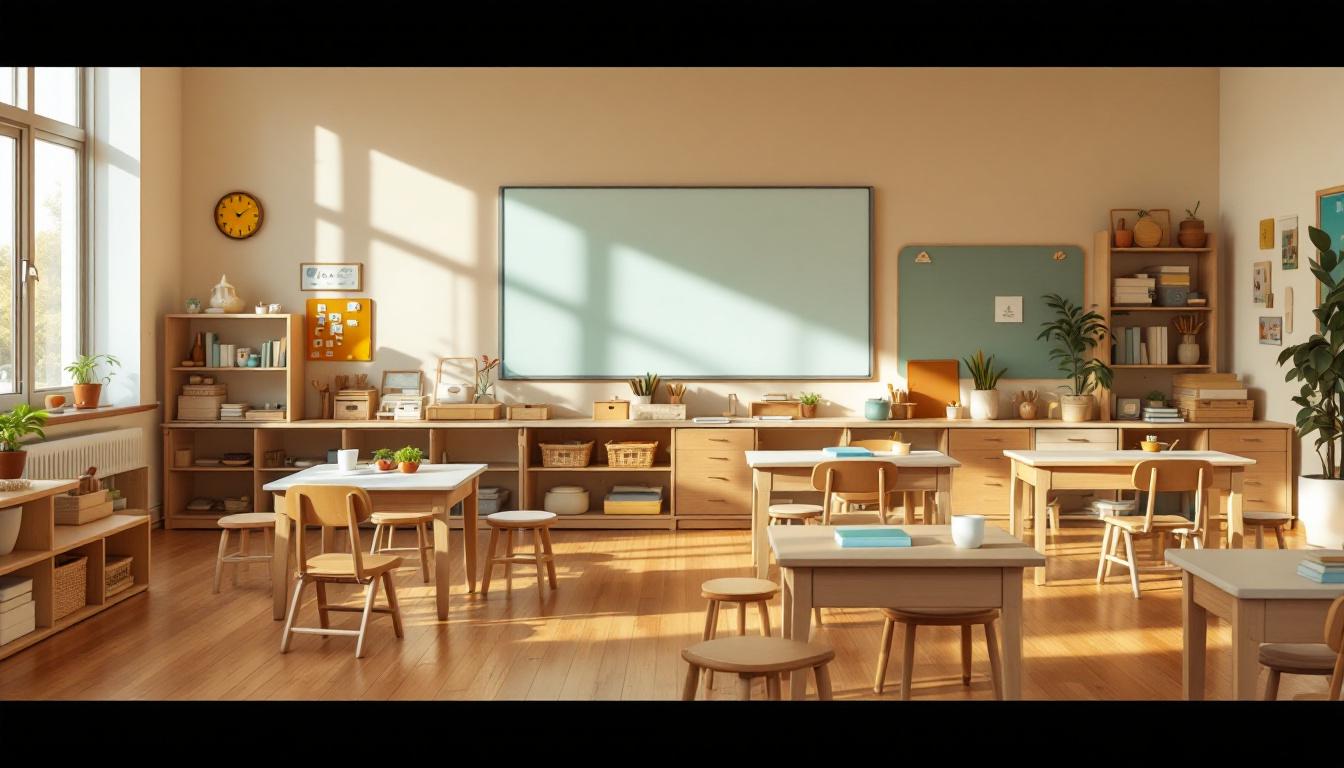Establishing the Foundation for Success in ABA Therapy
Creating an effective ABA therapy environment begins with deliberate planning and organization. Recognizing the individual needs of children with autism, these environments promote learning, independence, and emotional well-being by minimizing distractions, integrating visual supports, and establishing consistent routines. By applying principles derived from evidence-based therapies like TEACCH and ABA, clinicians and caregivers can craft spaces that not only facilitate skill development but also reduce anxiety and enhance motivation across varied settings.
Principles and Best Practices for Structured Environments
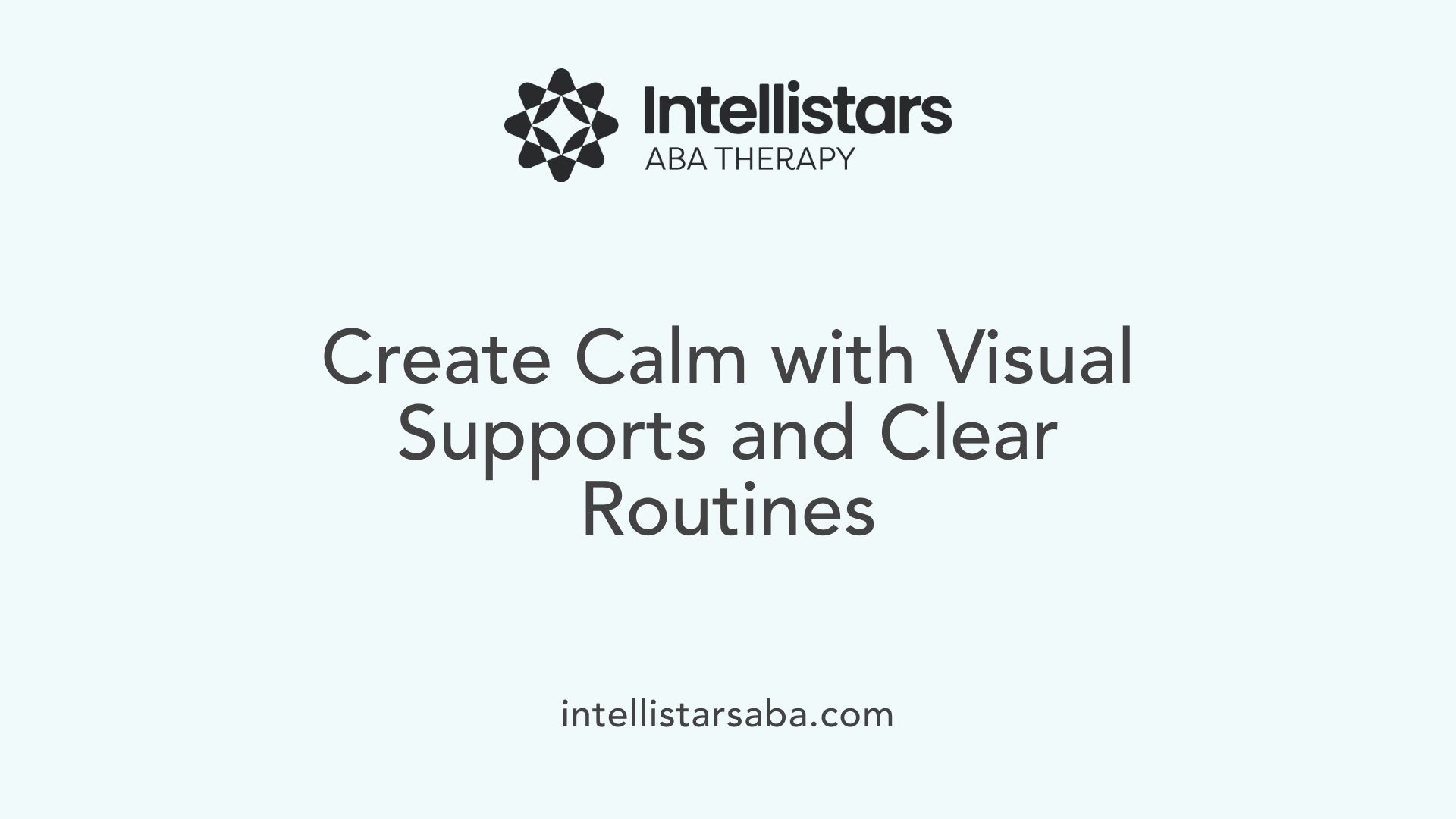
What are the principles and best practices for creating structured environments to enhance ABA therapy effectiveness?
Creating a well-organized and supportive environment is essential for effective ABA therapy, especially when working with children with autism. The foundation begins with organizing physical spaces to minimize distractions. This involves decluttering areas, using visual supports such as schedules, cues, and labels, and designating specific zones for different activities like play, learning, and relaxation.
Designated areas help children understand where certain activities occur, reducing confusion and anxiety. For example, establishing a calm corner for calming activities and a separate space for learning tasks can promote focus and independence.
Consistent routines and clear expectations further enhance the structured environment. Visual schedules and social stories outline daily routines and transitions, helping children anticipate what’s next and feel secure. Using visual cues, such as picture cards or timers, supports comprehension and self-regulation.
Incorporating sensory accommodations is another important aspect. Since children with autism may have diverse sensory needs—some seeking sensory input while others are sensitive to light, sound, or textures—creating areas with appropriate sensory tools and calming elements can reduce stress and promote engagement.
Reinforcement systems like tokens, stickers, or praise are used to motivate positive behaviors. Data collection tools, including behavior charts or digital tracking, allow practitioners to monitor progress and adjust strategies over time.
Together, these practices help foster skill development, improve independence, and support generalization of learned behaviors across settings. In turn, a thoughtfully designed environment not only amplifies the effectiveness of ABA interventions but also creates a safe, predictable space where children can thrive and achieve their developmental goals.
Strategies and Techniques for Autism-Friendly Settings
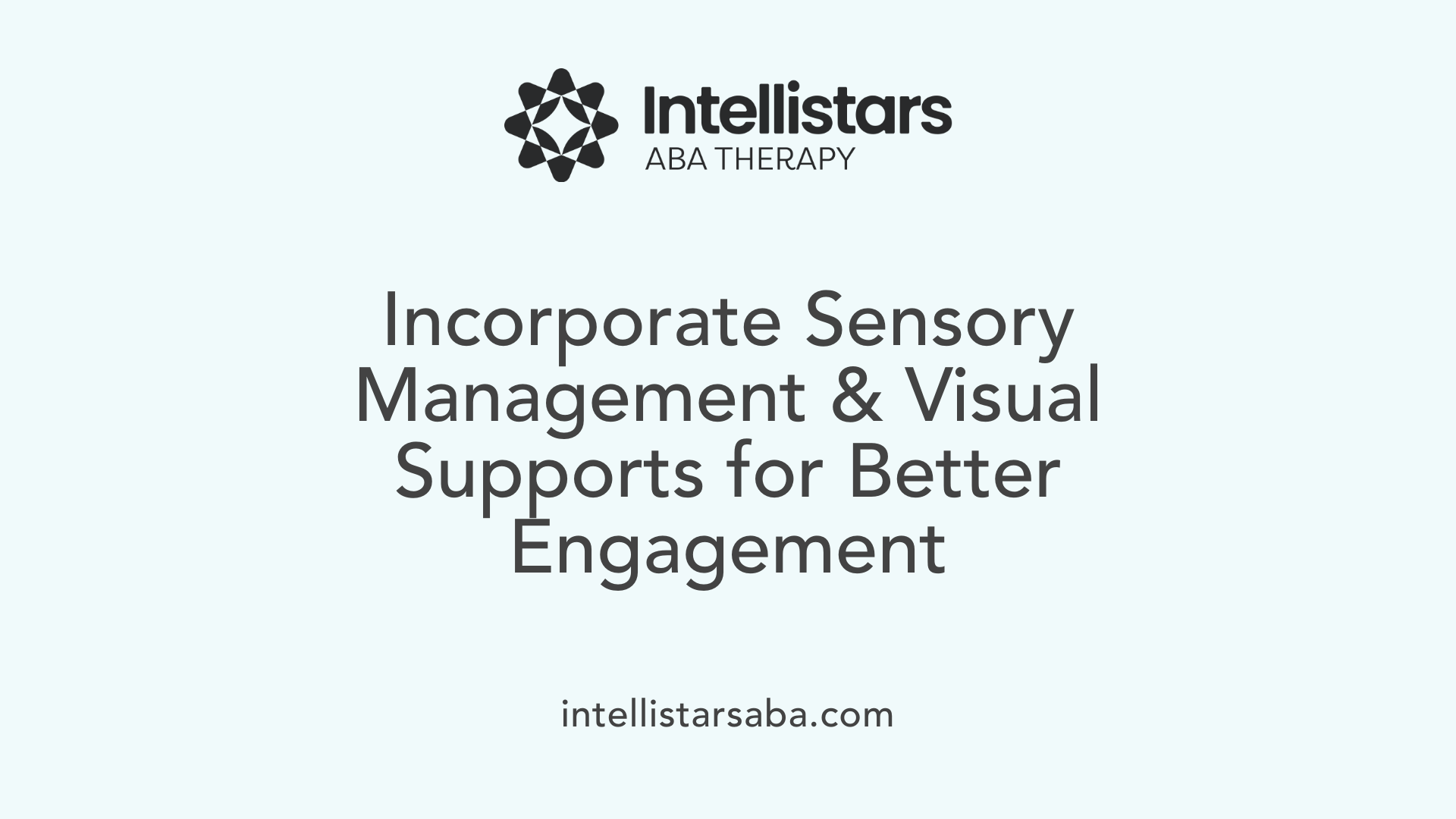
What strategies and techniques, including Natural Environment Teaching (NET), can be used to design autism-friendly and supportive settings?
Creating environments that support individuals with autism involves a combination of evidence-based, personalized modifications and approaches. At the core, understanding each person's unique sensory needs, preferences, and developmental level guides the design of effective strategies.
Environmental adjustments like sensory-friendly spaces with soft lighting, calming colors, and comfortable furnishings help reduce sensory overload. Noise-reducing materials and quiet zones also play a critical role in minimizing triggers that can cause stress or panic.
Visual supports are essential tools. Visual schedules, social stories, and cues help children understand routines, expectations, and transitions, reducing anxiety and increasing independence. Clear, consistent visual cues make it easier for children to navigate daily activities.
Natural Environment Teaching (NET) is a flexible, child-led approach that uses everyday routines and activities as learning opportunities. For example, sorting laundry, preparing snacks, or shopping can be integrated into teaching moments, promoting real-world skills in familiar contexts. This method aligns with principles from naturalistic interventions, emphasizing learning through play and daily routines.
Structured routines and clear communication further foster predictability. Using visual timers, checklists, and consistent schedules can help children anticipate events, which is soothing and enhances cooperation.
Sensory diets—individualized plans that incorporate activities like swinging, tactile play, or deep pressure—support self-regulation and help children manage sensory sensitivities. Teaching coping strategies and self-regulation techniques also empower children to handle sensory overload.
To ensure approaches remain effective, ongoing review and individualization are vital. Regular assessments and collaborations with caregivers help adapt interventions, ensuring they are scientifically grounded and tailored to each child's evolving needs.
In summary, designing autism-friendly settings involves integrating sensory management, visual supports, naturalistic teaching, and continuous personalization. These strategies collectively create safe, engaging, and supportive environments where autistic individuals can thrive.
Supporting Skill Development and Independence through Environmental Modifications
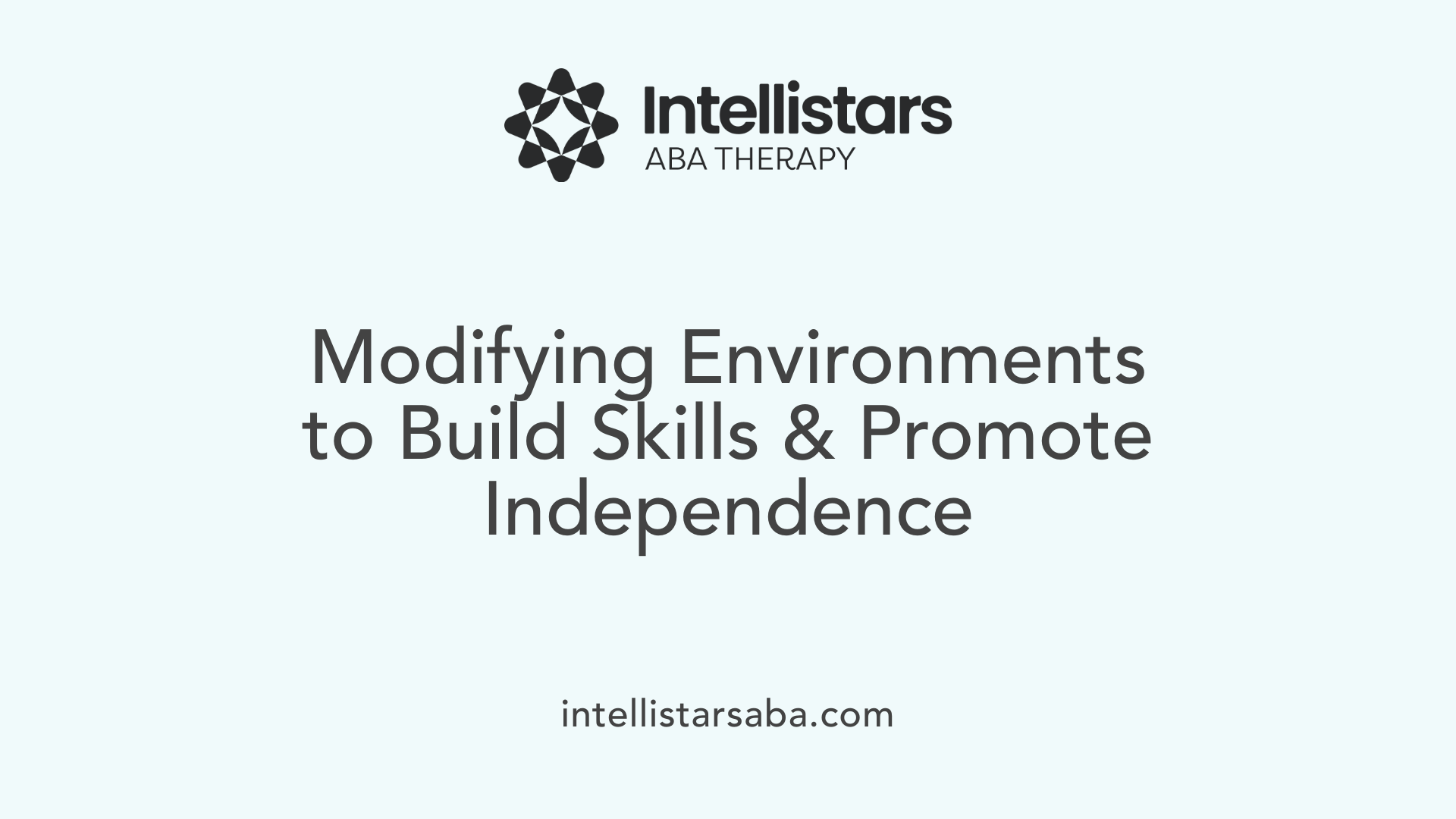
How can environmental modifications support skill development and independence in children with autism?
Creating a supportive environment is essential for helping children with autism develop skills and become more independent. Thoughtful modifications in their surroundings can make a significant difference.
Sensory adjustments such as dimming lights, using soft textures, or providing noise-canceling headphones help children manage sensory overload, which can otherwise lead to frustration or withdrawal. These adaptations help children stay calmer and more focused.
Visual cues and structured routines are powerful tools. Visual schedules, social stories, and cues enable children to understand daily routines, expectations, and transitions. Organized materials and designated zones, like clearly labeled drawers and clear workspace areas, reduce confusion and promote independence in organizing tasks and managing their environment.
Utilizing technology can further support learning and communication. Devices like picture exchange communication systems (PECS), tablets with educational apps, or virtual reality tools simulate real-world experiences, aiding in social skills and vocational training.
Physical adaptations also promote inclusion. Ramps, accessible furniture, and flexible spaces allow children with mobility challenges to participate fully in activities. Structured furniture layouts and adaptive tools support task completion and reduce physical barriers.
Encouraging emotional regulation and engagement is vital. Creating calming spaces with soft lighting, comforting textures, and sensory tools allows children to self-regulate and feel secure. Interactive zones and engaging activities foster motivation and focus.
In summary, these environmental modifications—ranging from sensory and physical adjustments to technological integrations and structured routines—are foundational in supporting skill development. They help children navigate everyday life with confidence, reduce anxiety, and build independence for a more autonomous future.
For further information, search using the phrase "Environmental modifications for skill development in autism" to explore tailored strategies and success stories applied in various settings.
Creating Sensory-Friendly, Calming, and Motivating Spaces
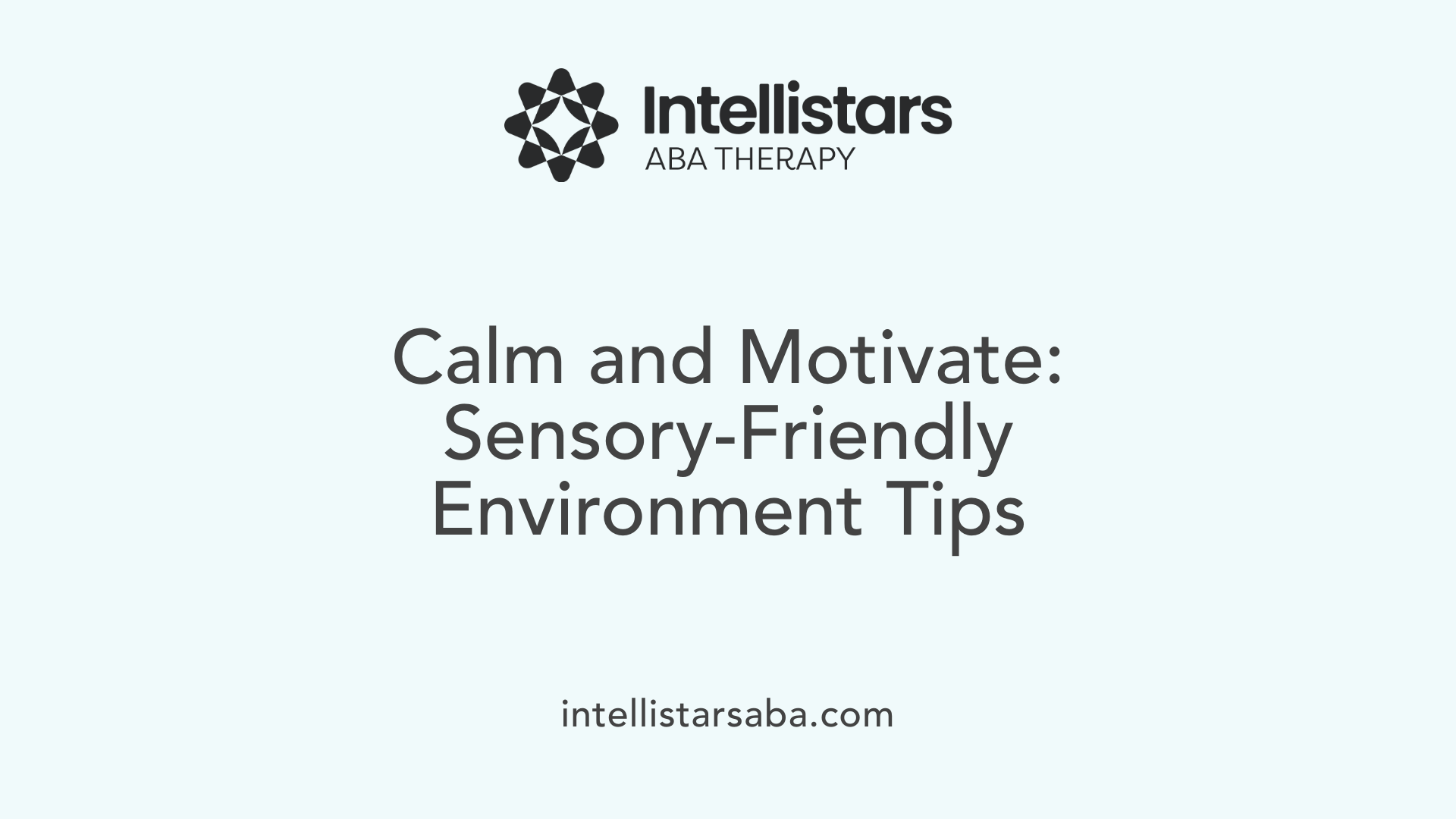
How can sensory-friendly, calming, and motivating spaces be created to enhance the effectiveness of ABA sessions?
Designing an environment that meets a child's sensory needs is essential for successful ABA therapy. Sensory-friendly spaces are tailored to reduce overstimulation and promote calmness, which helps children participate more effectively.
A good starting point is incorporating soft lighting, which minimizes harsh glare and creates a soothing atmosphere. Dimming lights or using lamps with warm tones can make the space more inviting. Noise reduction is equally important; using sound-absorbing materials like carpets, curtains, or acoustic panels can help diminish auditory distractions.
Calming visuals, such as nature images or simple, uncluttered wall decorations, help create a peaceful ambiance. Designated calm-down areas with comfortable seating, soft cushions, or cozy corners provide children with a refuge to self-regulate when overwhelmed.
Tactile toys and sensory equipment such as textured balls, weighted blankets, vibrating massage tools, or fidget toys support self-soothing and sensory regulation. These tools can be easily accessible in the environment to encourage engagement.
Flexible seating arrangements like bean bags, wobble stools, or therapy balls promote movement and comfort, catering to different sensory preferences. Clear visual cues, such as picture schedules, timers, or visual task prompts, help children understand routines and expectations, fostering focus.
Structured routines and predictable sequences in the space help children feel secure and motivated to engage in therapy tasks. Overall, creating an environment rich in sensory supports, organized with visual cues, and flexible in design helps maximize motivation, reduce anxiety, and support meaningful participation in ABA sessions.
Influence of Environment Structure on Different Types of ABA Therapy
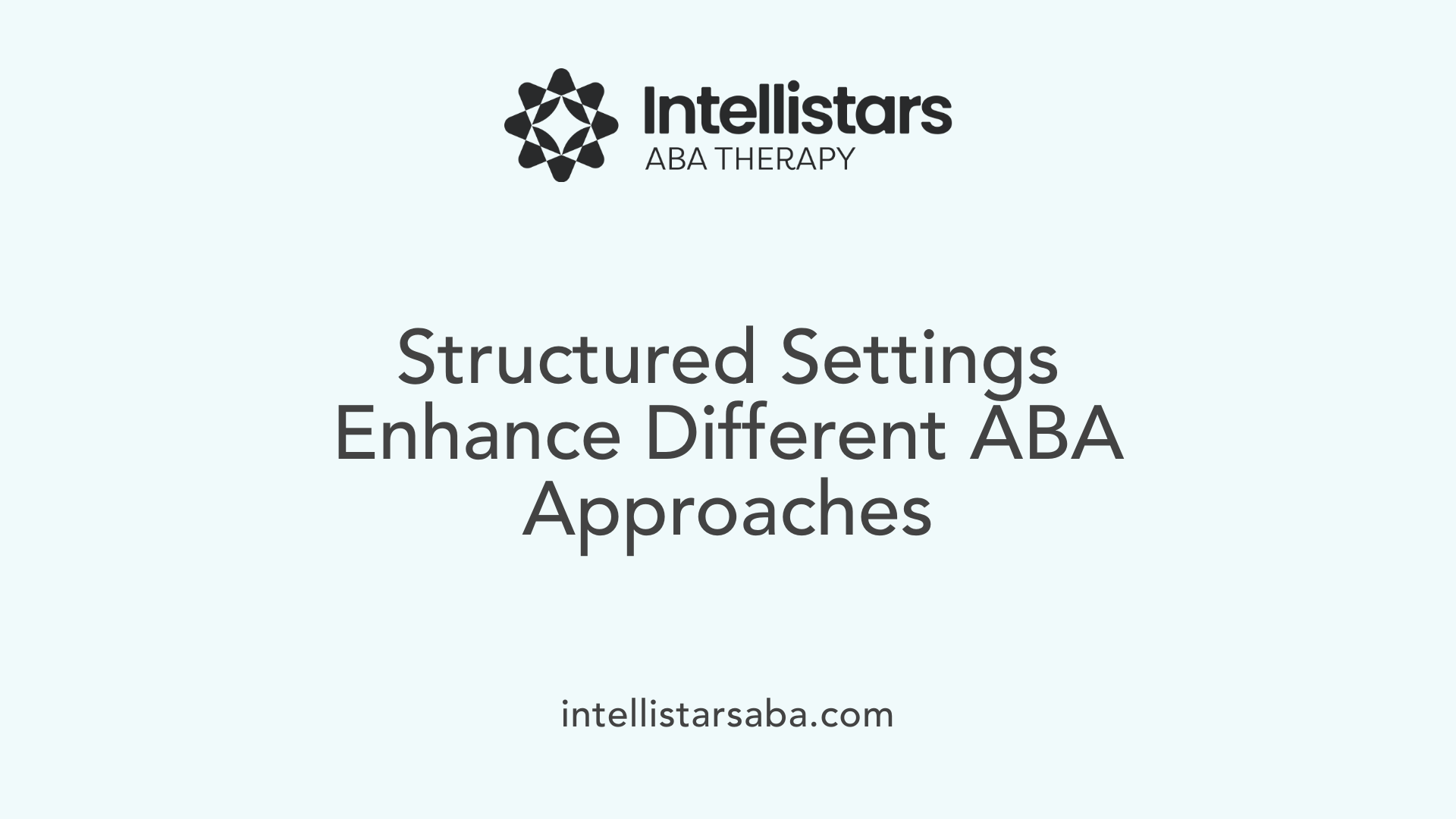
How does the structuring of the environment influence the success of different types of ABA therapy?
The way an environment is organized and structured significantly impacts the effectiveness of ABA therapy methods like Discrete Trial Training (DTT), Natural Environment Teaching (NET), and Pivotal Response Training (PRT). In structured settings, such as dedicated therapy rooms, minimizing sensory distractions and arranging materials systematically helps children focus and engage actively.
DTT benefits from carefully arranged environments where instructions are clear, and materials are easily accessible. This setup encourages quick responses and smooth transitions between tasks, reinforcing learning efficiently.
In contrast, NET thrives in naturally arranged environments like homes and community spaces. Here, the environment includes everyday objects and routines, making learning relevant and seamlessly integrated into daily life. For example, a child might learn to sort colors during laundry or count items during grocery shopping, reinforcing skills through real-world experiences.
PRT leverages motivation and responsiveness by creating engaging settings filled with preferred activities and stimuli tailored to the child's interests, which naturally foster social and communication skills.
The impact of environmental arrangements extends beyond immediate skill acquisition. Well-organized environments support the generalization of learned behaviors across settings. For example, a designated quiet corner at home can reinforce relaxation techniques learned during therapy, while visual schedules help children transition smoothly between activities both at home and school.
Using technology, like visual timers, electronic prompts, and data collection tools, further enhances treatment outcomes. These tools help track progress, adjust interventions, and maintain consistency across environments.
Overall, a thoughtfully structured environment creates a foundation for successful ABA interventions by promoting focus, reducing anxiety, and fostering independent learning. This tailored setting ensures that each child’s unique needs and preferences are considered, maximizing their developmental trajectory.
Integrating Structured Environments in Clinical and Home Settings
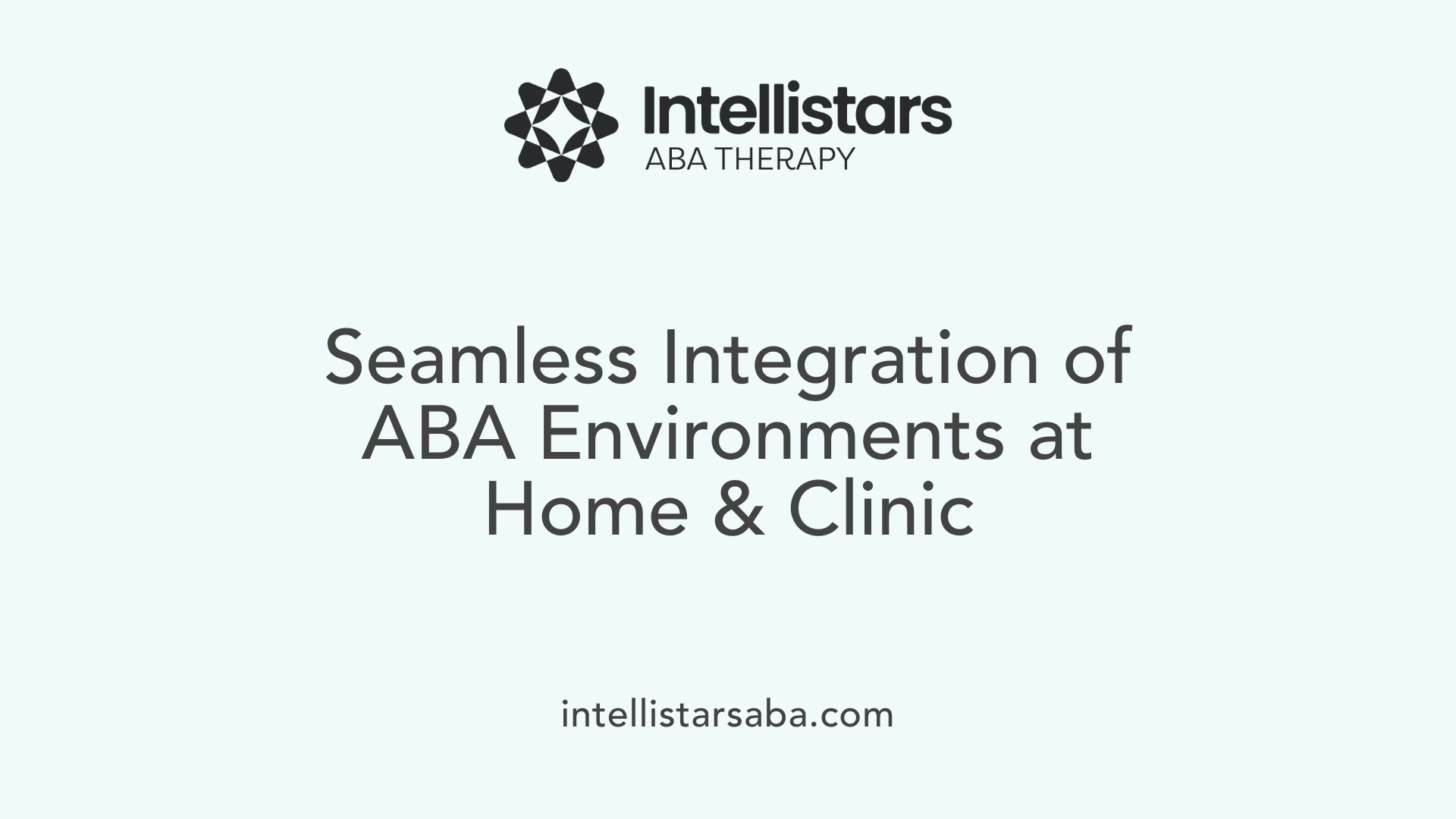
What are effective approaches for integrating structured environments in both clinical and home settings to optimize ABA outcomes?
Integrating structured environments effectively across clinical and home settings involves a blend of organized and natural teaching strategies. One of the fundamental methods is combining Discrete Trial Training (DTT) with Natural Environment Teaching (NET). DTT provides a highly structured, step-by-step approach to teaching new skills, focusing on clear instructions and immediate reinforcement. In contrast, NET emphasizes learning in real-life contexts by engaging children during their daily routines and play, promoting better skill transfer and generalization.
Establishing consistency is crucial. Using visual supports like schedules, social stories, and cues helps children understand expectations and transitions, reducing anxiety while promoting independence. Consistent routines—such as set times for therapy, meals, and play—foster predictability and comfort in both environments.
Child-led, interest-based strategies are particularly effective. Incorporating a child's preferences and motivations into learning activities—like sorting during chores or exploring toys—makes sessions engaging and meaningful. Modeling behaviors and encouraging imitation during natural interactions help children connect skills to everyday life.
Adjustments to the environment can support smooth transitions and reduce distractions. For instance, organizing materials, creating designated areas for specific activities, and minimizing sensory overload help children adapt more easily across settings.
Finally, ongoing collaboration between caregivers and clinicians ensures consistency in reinforcement, expectations, and strategies. Regular communication and shared goals optimize learning, support behavior management, and enhance overall outcomes in autism intervention programs.
| Approach | Description | Benefits |
|---|---|---|
| Discrete Trial Training (DTT) | Structured teaching with clear instructions and reinforcement | Skills acquisition, precise control, measurable progress |
| Natural Environment Teaching (NET) | Teaching in everyday settings based on child's interests | Generalization, motivation, real-world relevance |
| Visual Supports | Schedules, cues, and stories to enhance understanding | Reduces anxiety, promotes independence |
| Consistent Routines | Establishing predictable daily activities | Builds security, facilitates learning |
| Child Interest-Based Strategies | Engaging activities aligned with child's preferences | Increased motivation, meaningful engagement |
| Environmental Modifications | Arranging and organizing spaces for ease and focus | Supports transitions, reduces distractions |
| Caregiver-Clinician Collaboration | Continual communication and shared strategies | Consistent reinforcement, enhanced skill transfer |
By thoughtfully combining structured teaching with natural, child-centered approaches, and maintaining consistent routines reinforced by visual supports, intervention programs can maximize learning and independence. Collaboration between caregivers and professionals ensures these strategies work seamlessly, creating a supportive environment that promotes meaningful progress.
Implementation and Continuous Improvement of ABA Environments
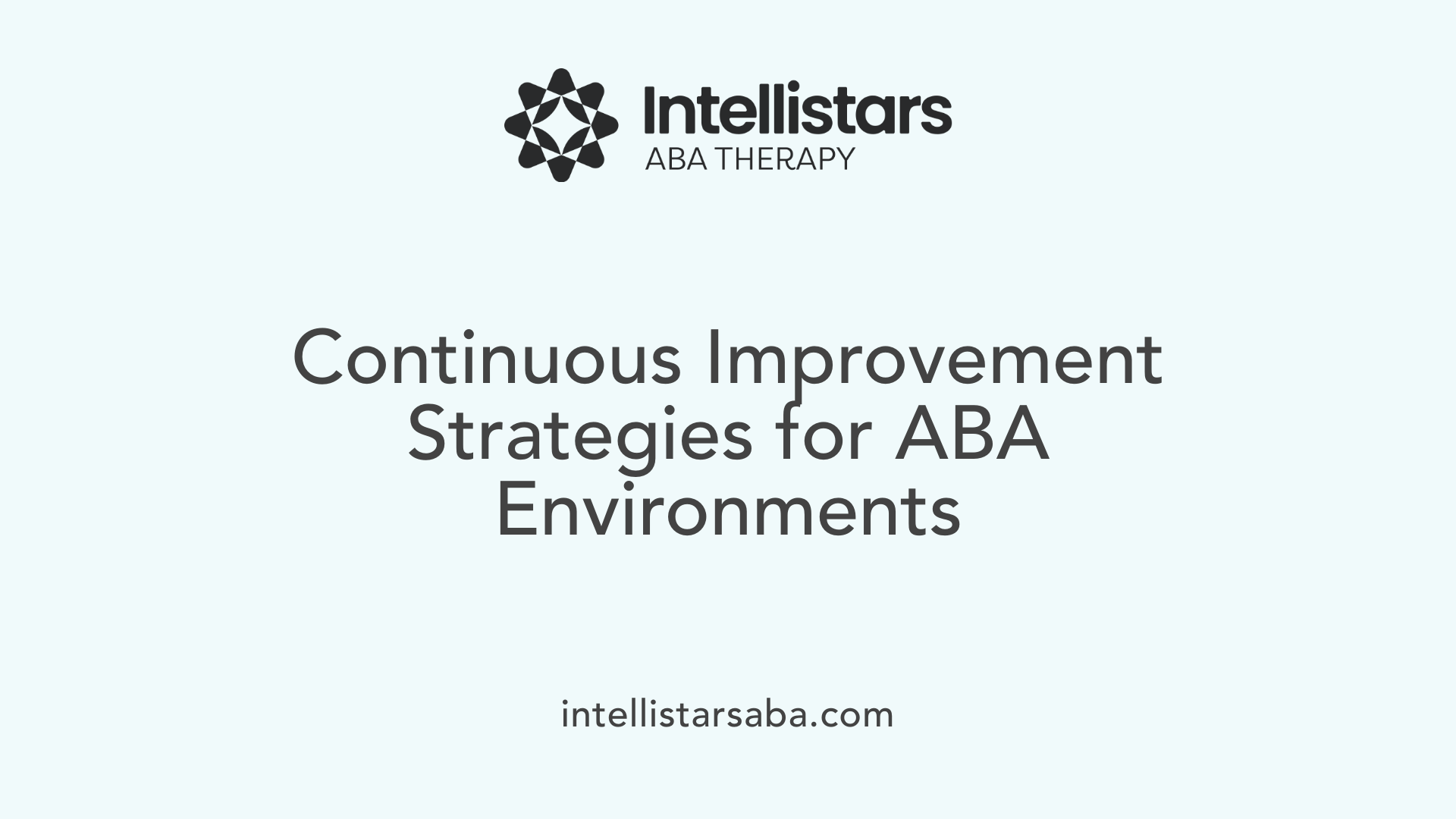
How can ABA environments be implemented and improved to support child development and learning?
Creating effective ABA environments starts with designing spaces that are both organized and predictable. This helps children with autism understand what to expect, reducing anxiety and fostering independence. A calm, clutter-free area with designated zones for different activities, visual schedules, and clear labels sets the stage for successful learning.
Regular assessment plays a crucial role in refining these environments. Professionals and caregivers observe how the child responds to sensory stimulations, organizational layout, and learning routines. Based on these observations, adjustments are made—such as changing sensory input levels, rearranging items for easier access, or modifying visual supports.
Incorporating evidence-based strategies like positive reinforcement, task analysis, prompting, and social skills training enhances the child's ability to learn desirable behaviors. Visual supports such as picture schedules, social stories, and visual cues help children grasp expectations and navigate transitions smoothly.
Consistent routines that include therapy sessions, mealtimes, and leisure activities create predictability, which is vital for maintaining engagement and reducing stress. Using reinforcement systems like tokens or stickers encourages children toward desired behaviors and progress.
Collaboration among trained professionals, including Board Certified Behavior Analysts (BCBAs), therapists, teachers, and family members, ensures interventions are tailored and responsive. Regular communication enables sharing insights, adjusting strategies, and maintaining consistency across settings.
Additionally, fostering skill development across multiple areas—communication, social interaction, self-care, and academics—is essential. Embedding learning in natural routines and everyday activities, known as Natural Environment Teaching (NET), helps skills transfer to real-world contexts.
Through ongoing evaluation and teamwork, ABA environments can continually evolve to better serve a child's individual needs, ultimately supporting meaningful development and lifelong learning.
Fostering Progress Through Thoughtful Environment Design
The deliberate creation and continuous refinement of structured, supportive environments are crucial in maximizing the effectiveness of ABA therapy. By integrating visual supports, sensory modifications, predictable routines, and child-centered strategies, caregivers and clinicians can foster meaningful learning and independence. The synergy of evidence-based practices such as TEACCH, NET, and positive reinforcement, combined with ongoing assessment and collaboration, ensures these environments remain responsive to each child's evolving needs. Thoughtful design not only enhances skill acquisition but also empowers children with autism to thrive across home, school, and community settings, paving the way for a more inclusive and supportive future.
References
- TEACCH vs. ABA: Key Differences and Benefits
- How to Implement Natural Environment Teaching in ABA Therapy
- Creating a Structured Home Environment to Support Child ...
- Effective ABA Techniques for Children with Autism - AutismCOE
- Creating an Autism-Friendly Home Environment
- Optimizing the Learning Environment: How ABA Skill Building Can ...
- A Guide to Natural Environment Teaching In ABA Therapy
- How to Effectively Do ABA Therapy at Home for Your Child - Ruby ABA
- Applied Behavior Analysis (ABA) | Autism Speaks

